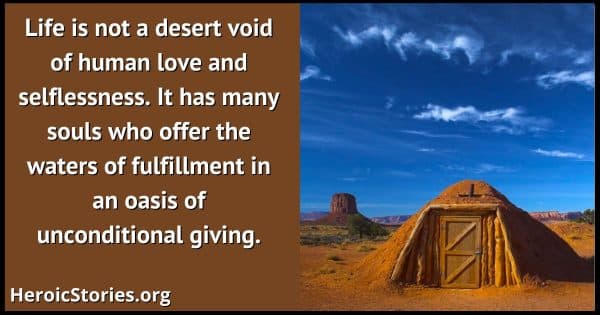by Marilyn Maple
Florida, USA

You’re not supposed to drive through sandstorms, but in 1958, my three-year-old daughter and I drove very slowly through one in the Painted Desert. Holding wet cloths over our mouths in order to breathe, we managed to weather all the sand that drifted into the car.
Once free from the ravages of the granular torrent, we looked for a place to stop. Signs tipped haphazardly in the sand promised a refuge. They read, “See the Prehistoric Animals” and pointed down what once had been a paved road. My daughter wanted to know what a prehistoric animal was. Knowing it would be an iguana or something like that, I told her it was a lizard.
Slowly inching our way down the road, praying we were still on concrete, we arrived at the site. The hogan itself looked prehistoric. It had withstood many sandstorms. A comparatively young Native American couple greeted us and filled our need for water. With a long drink for us and an even longer drink for the car, we began to look around.
The man told us he was a Blackfoot. The woman said she was a Sioux. This was their home and their business. They tracked animals to their lair and took one or two of the young to hand raise them,and sell them to circuses or zoos. Oh, by the way… the prehistoric monster was a lizard.
When I asked if they had any children, they told me that they had five. Three had died of TB and two had died of polio.
I continued my journalistic probing by asking them what they were striving for in life, living out here in this lonely desert. Excitedly they told me they were saving their money to go to Japan. Only then did I question whether I had really come through the storm or whether I was hallucinating the whole scene. I stared in disbelief. The desert? Two Native Americans? Japan?
With smiles on their faces and sparkling, enthusiastic dark eyes, they told me that a man had come by in 1948 or 49 and told them about all the poor war orphans in Japan and how there weren’t enough people who could house them.
So they had been saving their money ever since to afford a trip to Japan to bring back one or two war orphans.
I’ve never forgotten those moments standing in the desert. It was a time both real and unreal. Many times I go back to relive those moments, especially when I begin to doubt the goodness in humanity, the beauty of mankind, and the capability of caring that lies deep within all of us. I’ve never been so enriched.
Life is not a desert void of human love and selflessness. It has many souls who offer the waters of fulfillment in an oasis of unconditional giving.
Podcast: Play in new window | Download (Duration: 4:14 — 3.2MB)


I am a subscriber to Heroic Stories for many years now. This story “Life is not a Desert” is one of the moving and well written stories I have had the pleasure to read. Thank you very much for sharing.